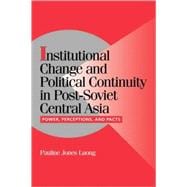Institutional Change and Political Continuity in Post-Soviet Central Asia: Power, Perceptions, and Pacts

Institutional Change and Political Continuity in Post-Soviet Central Asia: Power, Perceptions, and Pacts
- ISBN 13:
9780521801096
- ISBN 10:
0521801095
- Format: Hardcover
- Copyright: 04/29/2002
- Publisher: Cambridge University Press
.svg) Rent
From $73.08
Rent
From $73.08
List Price $111.00 Save
| TERM | PRICE | DUE |
|---|---|---|



List Price $111.00 Save $1.10
Special Order: 1-2 Weeks
We Buy This Book Back!
Free Shipping On Every Order
Note: Supplemental materials are not guaranteed with Rental or Used book purchases.
Extend or Purchase Your Rental at Any Time
Need to keep your rental past your due date? At any time before your due date you can extend or purchase your rental through your account.






